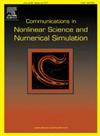非线性耦合Schrödinger系统新型结构保持非协调BDF2-FEM的无条件超收敛分析
IF 3.8
2区 数学
Q1 MATHEMATICS, APPLIED
Communications in Nonlinear Science and Numerical Simulation
Pub Date : 2025-07-14
DOI:10.1016/j.cnsns.2025.109132
引用次数: 0
摘要
本文主要研究了一种新的具有不符合EQ1rot单元的耦合非线性Schrödinger (CNLS)方程的保质保能两步倒推微分公式(BDF2)完全离散化格式。采用时兴的时空分裂方法和数学归纳法,严格推导了数值解在W0、∞范数上的有界性。然后,根据EQ1rot单元的特殊优点,通过相减相邻两时间层的误差方程和离散导数传递技巧,严格推导出h1 -范数破碎时不受网格大小和时间步长限制的无条件超接近结果。然后利用插值后处理技巧给出了相应的无条件超收敛误差估计。最后给出了5个数值算例来验证理论分析。值得注意的是,本文的结果也适用于各向异性网格,并得到了数值验证,并且改进了以往主要关注正则网格上符合元的最优误差估计的研究,以处理CNLS系统。本文章由计算机程序翻译,如有差异,请以英文原文为准。
Unconditional superconvergence analysis of a novel structure preserving nonconforming BDF2-FEM for coupled nonlinear Schrödinger system
This article mainly addresses a new mass and energy preserving two-step backward differential formula (BDF2) fully discretization scheme for the coupled nonlinear Schrödinger (CNLS) equations with nonconforming element. By means of the fashionable spatiotemporal splitting approach and the mathematical induction, the boundedness in -norm of the numerical solution is derived strictly. Then, based on the special virtues of element, through subtracting the error equations of two adjacent time layers and the discrete derivative transfer trick, the unconditional superclose result in the broken -norm, with no limitation between grid size and time step, is deduced rigorously. Whereafter, the corresponding unconditional superconvergence error estimate is presented using the interpolation post-processing skill. Finally, five numerical examples are offered to confirm the theoretical analysis. It is worth noting that the outcomes gained herein also apply to anisotropic mesh, which are numerically testified, moreover, they improve the previous studies which focused primarily on optimal error estimate with conforming elements on regular mesh for dealing with CNLS system.
求助全文
通过发布文献求助,成功后即可免费获取论文全文。
去求助
来源期刊

Communications in Nonlinear Science and Numerical Simulation
MATHEMATICS, APPLIED-MATHEMATICS, INTERDISCIPLINARY APPLICATIONS
CiteScore
6.80
自引率
7.70%
发文量
378
审稿时长
78 days
期刊介绍:
The journal publishes original research findings on experimental observation, mathematical modeling, theoretical analysis and numerical simulation, for more accurate description, better prediction or novel application, of nonlinear phenomena in science and engineering. It offers a venue for researchers to make rapid exchange of ideas and techniques in nonlinear science and complexity.
The submission of manuscripts with cross-disciplinary approaches in nonlinear science and complexity is particularly encouraged.
Topics of interest:
Nonlinear differential or delay equations, Lie group analysis and asymptotic methods, Discontinuous systems, Fractals, Fractional calculus and dynamics, Nonlinear effects in quantum mechanics, Nonlinear stochastic processes, Experimental nonlinear science, Time-series and signal analysis, Computational methods and simulations in nonlinear science and engineering, Control of dynamical systems, Synchronization, Lyapunov analysis, High-dimensional chaos and turbulence, Chaos in Hamiltonian systems, Integrable systems and solitons, Collective behavior in many-body systems, Biological physics and networks, Nonlinear mechanical systems, Complex systems and complexity.
No length limitation for contributions is set, but only concisely written manuscripts are published. Brief papers are published on the basis of Rapid Communications. Discussions of previously published papers are welcome.
 求助内容:
求助内容: 应助结果提醒方式:
应助结果提醒方式:


